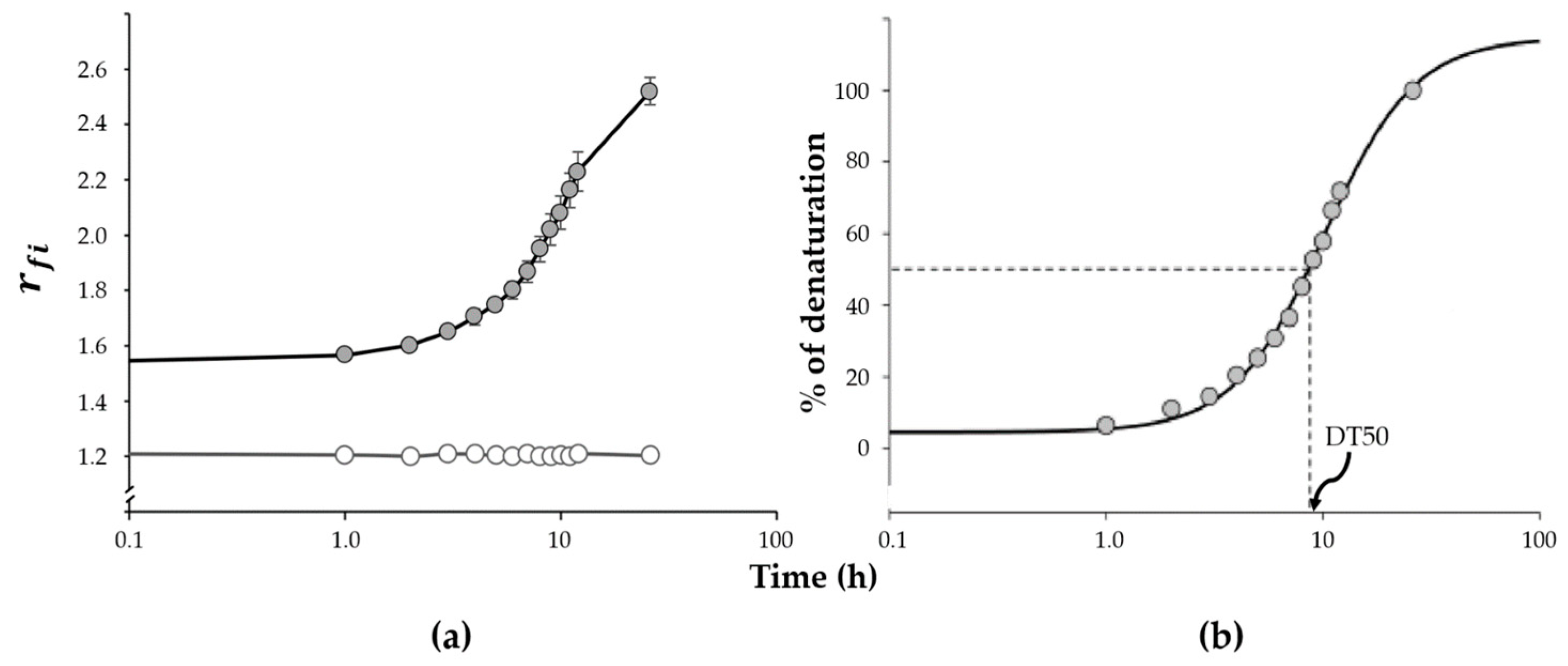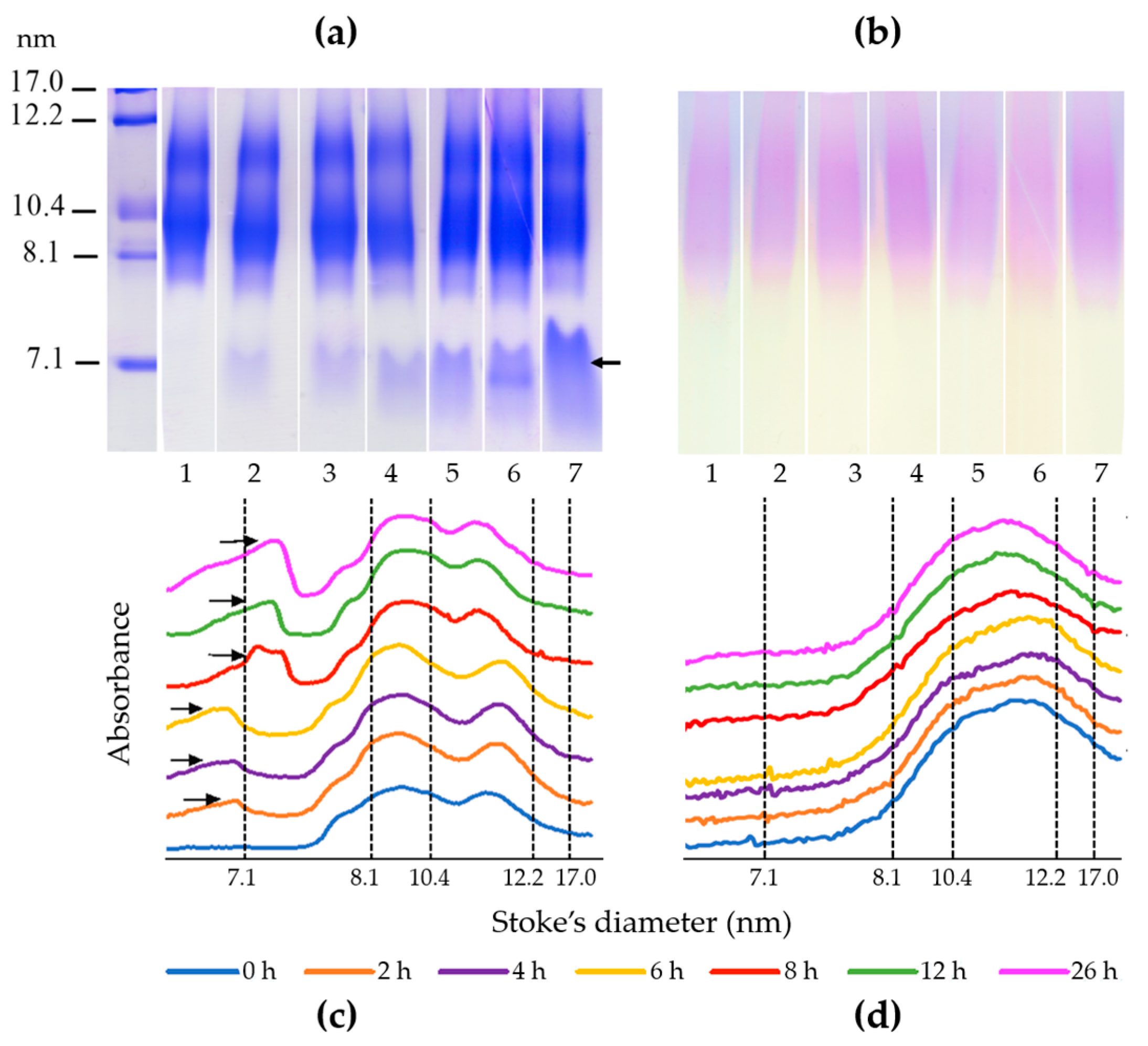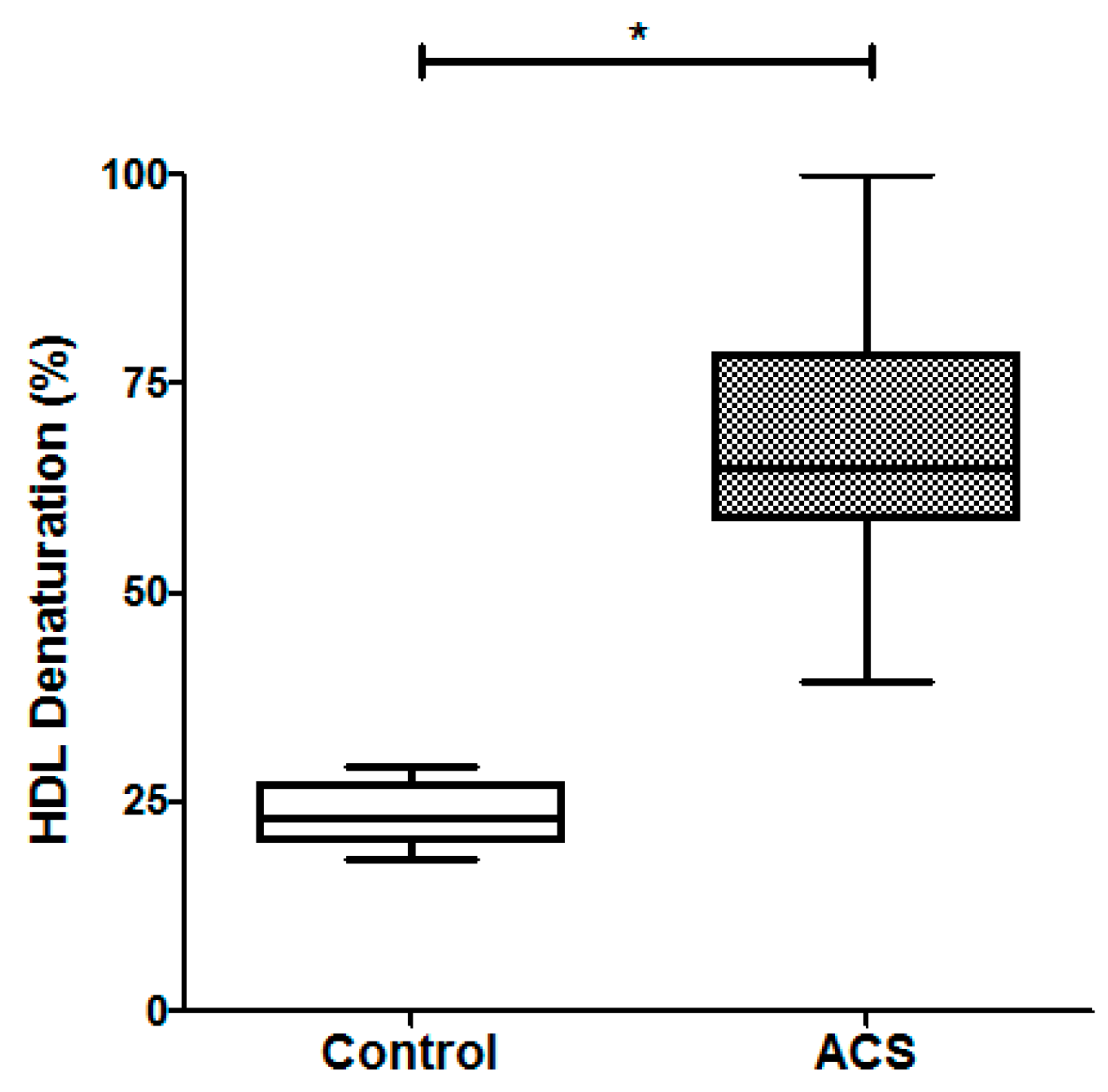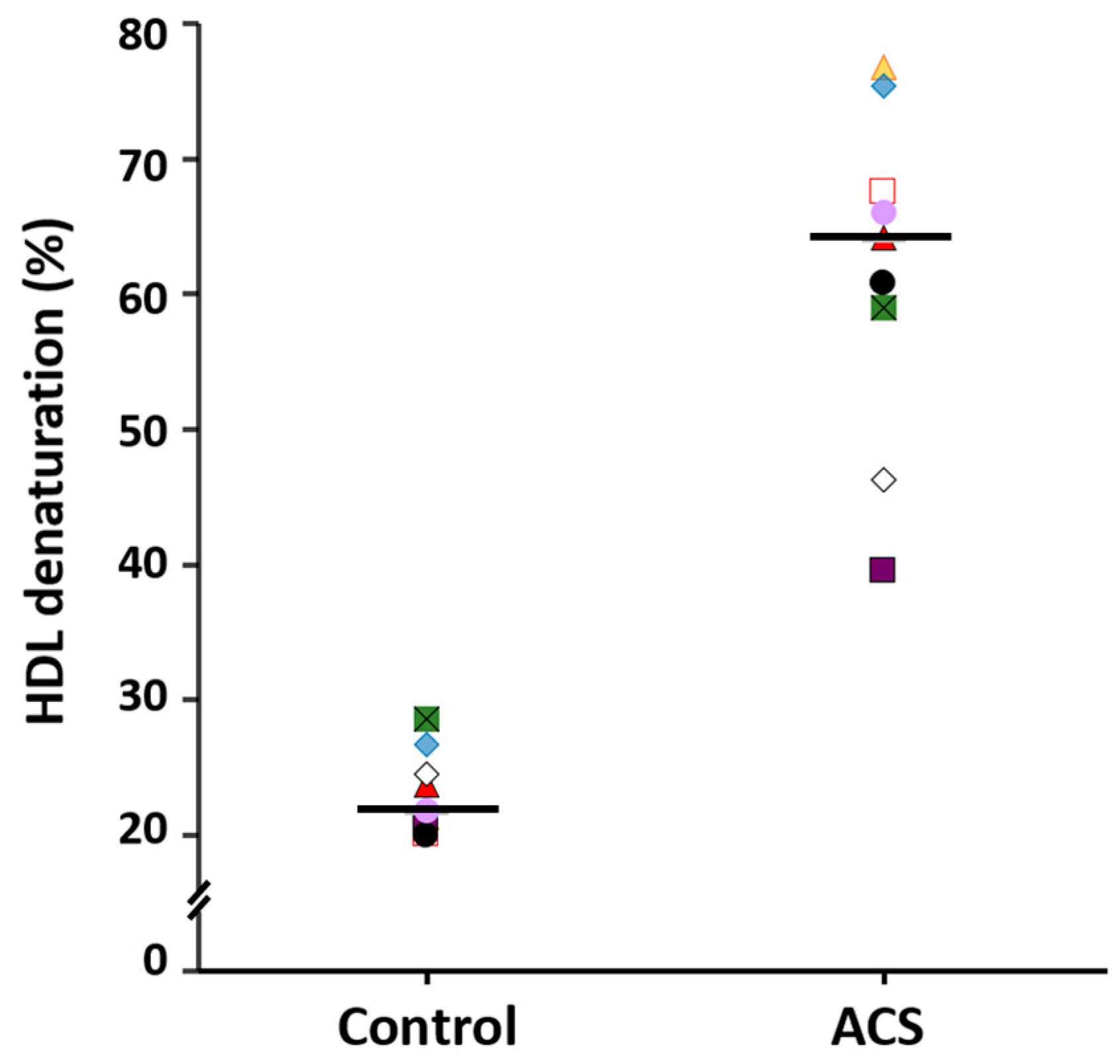Trp Fluorescence Redshift during HDL Apolipoprotein Denaturation Is Increased in Patients with Coronary Syndrome in Acute Phase: A New Assay to Evaluate HDL Stability
Abstract
1. Introduction
2. Results
2.1. Definition of The Meaningful Parameters to Estimate HDL Stability
2.2. Analysis of HDL Integrity during Denaturalization
2.3. Determination of the Percentage of HDL Proteins in Patients with ACS and Controls
3. Discussion
4. Materials and Methods
4.1. Study Population
4.2. Biochemical Analyses
4.3. Isolation of HDL
4.4. Redshift of Trp Fluorescence during HDL Denaturation
4.5. Analysis of HDL Integrity during Denaturalization
4.6. Statistical Analysis
5. Conclusions
Supplementary Materials
Author Contributions
Funding
Institutional Review Board Statement
Informed Consent Statement
Data Availability Statement
Acknowledgments
Conflicts of Interest
References
- Assmann, G.; Nofer, J.-R. Atheroprotective Effects of High-Density Lipoproteins. Annu. Rev. Med. 2003, 54, 321–341. [Google Scholar] [CrossRef] [PubMed]
- Estrada-Luna, D.; Ortiz-Rodriguez, M.A.; Medina-Briseño, L.; Carreón-Torres, E.; Izquierdo-Vega, J.A.; Sharma, A.; Cancino-Díaz, J.C.; Pérez-Méndez, O.; Belefant-Miller, H.; Betanzos-Cabrera, G. Current therapies focused on high-density lipoproteins associated with cardiovascular disease. Molecules 2018, 23, 2730. [Google Scholar] [CrossRef] [PubMed]
- Tang, X.; Mao, L.; Chen, J.; Zhang, T.; Weng, S.; Guo, X.; Kuang, J.; Yu, B.; Peng, D. High-sensitivity CRP may be a marker of HDL dysfunction and remodeling in patients with acute coronary syndrome. Sci. Rep. 2021, 11, 11444. [Google Scholar] [CrossRef]
- Sadana, P.; Lin, L.; Aghayev, M.; Ilchenko, S.; Kasumov, T. Early Pro-Inflammatory Remodeling of HDL Proteome in a Model of Diet-Induced Obesity: 2H2O-Metabolic Labeling-Based Kinetic Approach. Int. J. Mol. Sci. 2020, 21, 7472. [Google Scholar] [CrossRef] [PubMed]
- López-Olmos, V.; Carreón-Torres, E.; Luna-Luna, M.; Flores-Castillo, C.; Martínez-Ramírez, M.; Bautista-Pérez, R.; Franco, M.; Sandoval-Zárate, J.; Roldán, F.J.; Aranda-Fraustro, A. Increased HDL Size and Enhanced Apo A-I Catabolic Rates Are Associated With Doxorubicin-Induced Proteinuria in New Zealand White Rabbits. Lipids 2016, 51, 311–320. [Google Scholar] [CrossRef]
- Pietzsch, J.; Julius, U.; Nitzsche, S.; Hanefeld, M. In vivo evidence for increased apolipoprotein A-I catabolism in subjects with impaired glucose tolerance. Diabetes 1998, 47, 1928–1934. [Google Scholar] [CrossRef]
- Frénais, R.; Ouguerram, K.; Maugeais, C.; Mahot, P.; Maugère, P.; Krempf, M.; Margot, T. High density lipoprotein apolipoprotein AI kinetics in NIDDM: A stable isotope study. Diabetologia 1997, 40, 578–583. [Google Scholar] [CrossRef]
- Ooi, E.M.; Watts, G.F.; Farvid, M.S.; Chan, D.C.; Allen, M.C.; Zilko, S.R.; Barret, H.R. High-density lipoprotein apolipoprotein A-I kinetics in obesity. Obes. Res. 2005, 13, 1008–1016. [Google Scholar] [CrossRef]
- Pérez-Méndez, O.; Carreón-Torres, E.; Franco, M.; Juárez-Oropeza, M.A. HDL physicochemical characteristics as determinants of their plasma concentrations: What we have learned from thiazolidinediones. In HDL and LDL Cholesterol, 1st ed.; Pagano, I.S., Strait, N.B., Eds.; Nova Science: Hauppauge, NY, USA, 2009; pp. 145–170. [Google Scholar]
- Rothblat, G.H.; Phillips, M.C. High-density lipoprotein heterogeneity and function in reverse cholesterol transport. Curr. Opin. Lipidol. 2010, 21, 229–238. [Google Scholar] [CrossRef]
- Pollard, R.D.; Fulp, B.; Sorci-Thomas, M.G.; Thomas, M.J. High-Density Lipoprotein Biogenesis: Defining the Domains Involved in Human Apolipoprotein A-I Lipidation. Biochemistry 2016, 55, 4971–4981. [Google Scholar] [CrossRef] [PubMed]
- Massey, J.B.; Pownall, H.J. Spectroscopic studies of the tyrosine residues of human plasma apolipoprotein A-II. Biochim. Biophys. Acta. 1989, 999, 111–120. [Google Scholar] [CrossRef]
- Kameel, N.I.A.; Wong, Y.H.; Shuib, A.S.; Tayyab, S. Conformational analysis of champedak galactose-binding lectin under different urea concentrations. Plant Physiol. Biochem. 2016, 98, 57–63. [Google Scholar] [CrossRef]
- Eftink, M.R. The use of fluorescence methods to monitor unfolding transitions in proteins. Biochemistry 1998, 63, 276–284. [Google Scholar] [CrossRef]
- Vivian, J.T.; Callis, P.R. Mechanisms of Tryptophan Fluorescence Shifts in Proteins. Biophys. J. 2001, 80, 2093–2109. [Google Scholar] [CrossRef]
- Horowitz, B.S.; Goldberg, I.J.; Merab, J.; Vanni, T.M.; Ramakrishnan, R.; Ginsberg, H.N. Increased plasma and renal clearance of an exchangeable pool of apolipoprotein A-I in subjects with low levels of high density lipoprotein cholesterol. J. Clin. Investig. 1993, 91, 1743–1752. [Google Scholar] [CrossRef]
- Di Costanzo, A.; Ronca, A.; D’Erasmo, L.; Manfredini, M.; Baratta, F.; Pastori, D.; Di Mar-tino, M.; Ceci, F.; Angelico, F.; Del Ben, M.; et al. HDL-Mediated Cholesterol Efflux and Plasma Loading Capacities Are Altered in Subjects with Metabolically- but Not Genetically Driven Non-Alcoholic Fatty Liver Disease (NAFLD). Biomedicines 2020, 8, 625. [Google Scholar] [CrossRef]
- Quintanilla-Cantú, A.; Peña-de-la-Sancha, P.; Flores-Castillo, C.; Mejía-Domínguez, A.M.; Posadas-Sánchez, R.; Pérez-Hernández, N.; Bautista-Pérez, R.; Enriquez-Calderón, R.E.; Juárez-Oropeza, M.A.; Fragoso, J.M.; et al. Small HDL subclasses become cholesterol-poor during postprandial period after a fat diet intake in subjects with high triglyceridemia increases. Clin. Chim. Acta 2017, 464, 98–105. [Google Scholar] [CrossRef]
- Norata, G.D.; Pirillo, A.; Catapano, A.L. Modified HDL: Biological and physiopathological consequences. Nutr. Metab. Cardiovasc. Dis. 2006, 16, 371–386. [Google Scholar] [CrossRef] [PubMed]
- Jayaraman, S.; Haupt, C.; Gursky, O. Thermal transitions in serum amyloid A in solution and on the lipid: Implications for structure and stability of acute-phase HDL. J. Lipid Res. 2015, 56, 1531–1542. [Google Scholar] [CrossRef] [PubMed]
- González-Pacheco, H.; Bojalil, R.; Amezcua-Guerra, L.M.; Sandoval, J.; Eid-Lidt, G.; Arias-Mendoza, A.; Azar-Manzur, F.; Álvarez-Sangabriel, A.; Altamirano-Castillo, A.; Briseño-Cruz, J.L.; et al. Derivation and validation of a simple inflammation-based risk score system for predicting in-hospital mortality in acute coronary syndrome patients. J. Cardiol. 2019, 73, 416–424. [Google Scholar] [CrossRef]
- Cannon, C.P.; Battler, A.; Brindis, R.G.; Cox, J.L.; Ellis, S.G.; Every, N.R.; Flaherty, J.T.; Harrington, R.A.; Krumholz, H.M.; Simoons, M.L.; et al. American College of Cardiology key data elements and definitions for measuring the clinical management and outcomes of patients with acute coronary syndromes. A report of the American College of Cardiology Task Force on Clinical Data Standards (Acute Coronary Syndromes Writing Committee). J. Am. Coll. Cardiol. 2001, 38, 2114–2130. [Google Scholar] [CrossRef] [PubMed]
- Villarreal-Molina, T.; Posadas-Romero, C.; Romero-Hidalgo, S.; Antúnez-Argüelles, E.; Bautista-Grande, A.; Vargas-Alarcón, G.; Kimura-Hayama, E.; Canizales-Quinteros, S.; Juárez-Rojas, J.G.; Posadas-Sánchez, R.; et al. The ABCA1 gene R230C variant is associated with decreased risk of premature coronary artery disease: The genetics of atherosclerotic disease (GEA) study. PLoS ONE 2012, 7, e49285. [Google Scholar] [CrossRef] [PubMed]
- Luna-Luna, M.; Criales-Vera, S.; Medina-Leyte, D.; Díaz-Zamudio, M.; Flores-Zapata, A.; Cruz-Robles, D.; López-Meneses, M.; Olvera-Cruz, S.; Ramírez-Marroquín, S.; Flores-Castillo, C.; et al. Bone Morphogenetic Protein-2 and Osteopontin Gene Expression in Epicardial Adipose Tissue from Patients with Coronary Artery Disease Is Associated with the Presence of Calcified Atherosclerotic Plaques. Diabetes Metab. Syndr. Obes. 2020, 11, 1943–1951. [Google Scholar] [CrossRef] [PubMed]
- Lowry, O.H.; Rosebrough, N.J.; Farr, A.L.; Randall, R.J. Protein measurement with the Folin phenol reagent. J. Biol. Chem. 1951, 193, 265–275. [Google Scholar] [CrossRef]
- Toledo-Ibelles, P.; García-Sánchez, C.; Ávila-Vazzzini, N.; Carreón-Torres, E.; Posadas-Romero, C.; Vargas-Alarcón, G.; Pérez-Méndez, O. Enzymatic assessment of cholesterol on electrophoresis gels for estimating HDL size distribution and plasma concentrations of HDL subclasses. J. Lipid Res. 2010, 51, 1610–1617. [Google Scholar] [CrossRef] [PubMed]
- García-Sánchez, C.; Torres-Tamayo, M.; Juárez-Meavepeña, M.; López-Osorio, C.; Toledo-Ibelles, P.; Monter-Garrido, M.; Cruz-Robles, D.; Carreón-Torres, E.; Vargas-Alarcón, G.; Pérez-Méndez, O. Lipid plasma concentrations of HDL subclasses determined by enzymatic staining on polyacrylamide electrophoresis gels in children with metabolic syndrome. Clin. Chim. Acta 2011, 412, 292–298. [Google Scholar] [CrossRef]
- Juárez-Meavepeña, M.; Carreón-Torres, E.; López-Osorio, C.; García-Sánchez, C.; Gamboa, R.; Torres-Tamayo, M.; Fragoso, J.M.; Rodríguez-Pérez, J.M.; Vargas-Alarcón, G.; Pérez-Méndez, O. The Srb1+1050T allele is associated with metabolic syndrome in children but not with cholesteryl ester plasma concentrations of high-density lipoprotein subclasses. Metab. Syndr. Relat. Disord. 2012, 10, 110–116. [Google Scholar] [CrossRef]
- Patra, M.; Mukhopadhyay, C.; Chakrabarti, A. Probing conformational stability and dynamics of erythroid and nonerythroid spectrin: Effects of urea and guanidine hydrochloride. PLoS ONE 2015, 10, e0116991. [Google Scholar] [CrossRef][Green Version]





| Parameter | Control Subjects (n = 20) | ACS Patients (n = 24) | * p Value |
|---|---|---|---|
| Age (years) | 57 ± 1.87 | 55 ± 2.57 | NS a |
| Sex, n [M (%)/F (%)] | 12 (60)/8 (40) | 19(79.16)/5(20.83) | NS c |
| Body mass index (kg/m2) | 25.28 ± 2.13 | 27.81 ± 5.94 | 0.034 b |
| Systolic blood pressure (mmHg) | 112.6 ± 2.18 | 121.5 ± 3.64 | NS a |
| Diastolic blood pressure (mmHg) | 71 [68.12–75.37] | 70 [67.75–74.00] | NS b |
| Alcohol drink, n (%) | 16 (80) | 7 (29) | 0.001 c |
| Active smokers, n (%) | 4 (20) | 10 (41.66) | NS c |
| Statin use, n (%) | 0 (0) | 21 (88) | 0.000 c |
| β-blockers use, n (%) | 0 (0) | 13 (54) | 0.000 c |
| Calcium inhibitor antagonists use, n (%) | 0 (0) | 5 (20.83) | 0.000 c |
| Glucose (mg/dL) | 92.95 [86.2–95.17] | 100.80 [94.07–138.98] | 0.000 b |
| Total cholesterol (mg/dL) | 179.78 ± 5.20 | 135.94 ± 7.08 | 0.000 a |
| LDL-cholesterol (mg/dL) | 106.11 ± 4.96 | 81.11 ± 5.56 | 0.002 a |
| Triglycerides (mg/dL) | 128.09 ± 9.32 | 142.35 ± 11.32 | NS a |
| HDL-cholesterol (mg/dL) | 53.17 ± 2.49 | 34.60 ± 2.06 | 0.000 a |
| HDL-triglycerides | 19.7 ± 3.9 | 27.5 ± 10.5 | 0.003 a |
| HDL-phospholipids | 109.4 ± 20.3 | 78.8 ± 20.4 | 0.000 a |
| Apo A-I | 154.8 ± 19.9 | 106.4 ± 27.6 | 0.000 a |
| ALT (IU/L) | 18.65 [12.93–24.17] | 30.10 [16.05–67.65] | 0.022 b |
| AST (IU/L) | 20.90 [17.83–23.70] | 32.90 [22.73–112.17] | 0.000 b |
| Uric acid (mg/dL) | 5.48 ± 0.28 | 6.90 ± 0.44 | 0.013 a |
| Creatinine (mg/dL) | 0.921 ± 0.044 | 1.16 ± 0.18 | NS a |
| Parameter | r | p |
|---|---|---|
| BMI | 0.312 | 0.044 |
| Glucose | 0.501 | 0.001 |
| Total cholesterol | −0.559 | 0.000 |
| LDL-cholesterol | −0.382 | 0.013 |
| AST | 0.406 | 0.008 |
| Uric acid | 0.316 | 0.044 |
| HDL-cholesterol | −0.684 | 0.000 |
| HDL-triglycerides | 0.450 | 0.002 |
| HDL-phospholipids | −0.673 | 0.000 |
| Apo A-I | −0.706 | 0.000 |
| Apo A-I-to-HDL-cholesterol ratio | 0.311 | 0.045 |
| Apo A-I-to-HDL-triglycerides ratio | −0.666 | 0.000 |
| Apo A-I-to-HDL-phospholipids ratio | 0.040 | 0.802 |
Publisher’s Note: MDPI stays neutral with regard to jurisdictional claims in published maps and institutional affiliations. |
© 2021 by the authors. Licensee MDPI, Basel, Switzerland. This article is an open access article distributed under the terms and conditions of the Creative Commons Attribution (CC BY) license (https://creativecommons.org/licenses/by/4.0/).
Share and Cite
López-Olmos, V.; Luna-Luna, M.; Carreón-Torres, E.; González-Pacheco, H.; Bautista-Pérez, R.; Posadas-Sánchez, R.; Fragoso, J.M.; Vargas-Alarcón, G.; Pérez-Méndez, Ó. Trp Fluorescence Redshift during HDL Apolipoprotein Denaturation Is Increased in Patients with Coronary Syndrome in Acute Phase: A New Assay to Evaluate HDL Stability. Int. J. Mol. Sci. 2021, 22, 7819. https://doi.org/10.3390/ijms22157819
López-Olmos V, Luna-Luna M, Carreón-Torres E, González-Pacheco H, Bautista-Pérez R, Posadas-Sánchez R, Fragoso JM, Vargas-Alarcón G, Pérez-Méndez Ó. Trp Fluorescence Redshift during HDL Apolipoprotein Denaturation Is Increased in Patients with Coronary Syndrome in Acute Phase: A New Assay to Evaluate HDL Stability. International Journal of Molecular Sciences. 2021; 22(15):7819. https://doi.org/10.3390/ijms22157819
Chicago/Turabian StyleLópez-Olmos, Victoria, María Luna-Luna, Elizabeth Carreón-Torres, Héctor González-Pacheco, Rocío Bautista-Pérez, Rosalinda Posadas-Sánchez, José Manuel Fragoso, Gilberto Vargas-Alarcón, and Óscar Pérez-Méndez. 2021. "Trp Fluorescence Redshift during HDL Apolipoprotein Denaturation Is Increased in Patients with Coronary Syndrome in Acute Phase: A New Assay to Evaluate HDL Stability" International Journal of Molecular Sciences 22, no. 15: 7819. https://doi.org/10.3390/ijms22157819
APA StyleLópez-Olmos, V., Luna-Luna, M., Carreón-Torres, E., González-Pacheco, H., Bautista-Pérez, R., Posadas-Sánchez, R., Fragoso, J. M., Vargas-Alarcón, G., & Pérez-Méndez, Ó. (2021). Trp Fluorescence Redshift during HDL Apolipoprotein Denaturation Is Increased in Patients with Coronary Syndrome in Acute Phase: A New Assay to Evaluate HDL Stability. International Journal of Molecular Sciences, 22(15), 7819. https://doi.org/10.3390/ijms22157819






